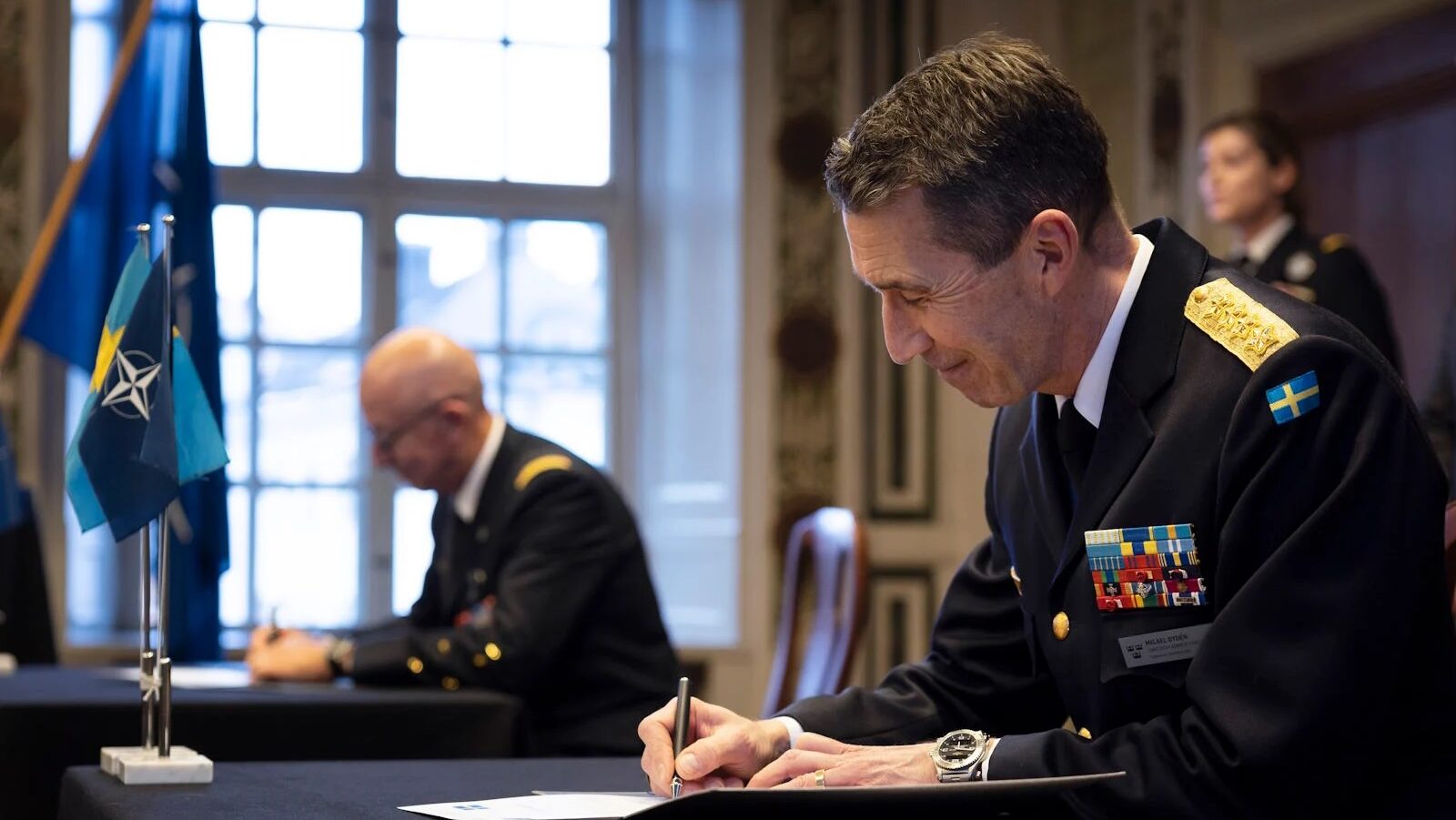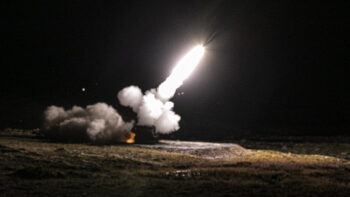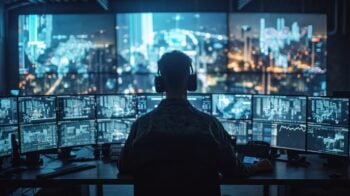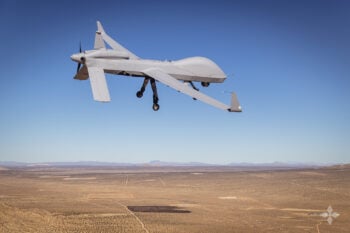
Swedish Chief of Defence Gen. Micael Bydén (R), signs the Joint Declaration finalizing military integration into the NATO Alliance on April 26. (NATO)
WASHINGTON — Gen. Micael Byden was appointed Supreme Commander of Sweden’s military in 2015, a job whose requirements changed dramatically in 2022, when Russia invaded Ukraine and after 200 years of military non-alignment, Stockholm moved to join NATO.
Incorporating Sweden into NATO, Byden told Breaking Defense during a recent visit to Washington, was something he “never thought” he’d see, but the former Swedish Air Force pilot said that the new responsibilities mean “It’s never been so inspirational to go to work.”
Byden discussed NATO integration, his view of Russian forces in the region, and how he hopes to spend an expected boost in defense spending. This interview has been edited lightly for clarity and length.
BREAKING DEFENSE: Russia has pulled a lot of forces out of the region to go to Ukraine. Do you feel you have a window of security here where Russia is simply too distracted by Ukraine that they can’t cause problems for the Nordic nations?
GEN. MICAEL BYDEN: You’re right, when it comes to ground assets, they are tied up in Ukraine. But it doesn’t necessarily mean that the Russians cannot act. They have capabilities in the air, they have maritime or naval assets, they do nonlinear warfare — information operations, cyber attacks and whatever. So they can still act. But I’m not looking at huge Russian army units coming over the border, we don’t see that. They have ambitions to reinforce their presence east of Finland, that’s something we’ll look at.
If we talk about the window of opportunity, the window of opportunity is there for us to reinforce, and build stronger national defenses to be used as NATO deterrence. And for collective defense today, it’s needed. So it’s more the window to act now, not waiting. If this is a window of three or five years or more, I don’t know better than anyone else. It’s a window, it’s there, and we [will] do whatever we can to build a stronger national defense.
On April 26, you completed full military integration into the NATO alliance. How did that process go?
We have been a close partner for 30 years, we have trained and exercised together, we have been in operations together. So I mean, we know each other by heart, I would say. The trust is there, we know people. So [in May 2022, the NATO] application goes in, and the accession and integration work starts — and then of course, it was frustrating for us waiting. But we were not just sitting there waiting, we were able to do a lot. We listened very carefully to Finland on what happened, what took them by surprise. So far, maybe it happens later on, but we have not been overwhelmed by information or questions we were not prepared to take on. The integration process and having an accession and integration working group, that’s done. It does not mean that we are fully integrated, this will be an ongoing process for years. When it comes to command and control systems, cryptology, everything that needs to be there, we need to learn all the processes. It will take some five, six, maybe seven years before we’re fully integrated with [personnel across NATO], and that’s in line with the requirements.
Ok, so what are short-term integration moves we might see?
Well, in the close dialogue, [we] understood the expectations of the requirements early, that we need to step in early to do things. Air policing would be one area take responsibility. The maritime domain in our region, meaning the Baltic Sea, that’s another part. As soon as possible, be part of the IAMD, integrated missile and air defense. So these would be three examples. And another would be, we need to put a lot of effort and investments in host nation support. Because we need to create a situation where huge military units can come in and start their preparation or come to operations early or transit through country west to east or south to north. Forward land forces as well. It’s a political decision to send a battalion unit to Latvia, somewhere around New Year’s, hopefully before New Year’s, but could happen after. That will be a ‘battalion minus,’ I would say, some 500 soldiers.
Specific to air defense, do you have near-term requirements and plans for how to approach that on an alliance level?
The short-term goals would be air policing. I mean, we do our own national air policing. That asset could very easily — and it’s already done, I would say, we just hand over the command for these fighters to be command and controlled by CAOC somewhere else. So first of all, we can do it in Swedish territory, we can do it in international waters. But now we also need a process to make sure that we can also do the job over other national territories, probably the ones around the Baltic Sea. So that would be your short term one. And then, our own technical systems need to be fully integrated. So interoperability in all aspects of everything from — language, I don’t worry about but on the technical part, there are a few things, including cryptology. It’s quite a lot of technical integration where we have things we need to do in the very short term.
Are you actually going to be able to get all that done near-term?
It has to be done. But there are things we can’t do on our own behalf right now. And a big one [is] the major C2 systems for air defense, as our own system is [for domestic use only]. So that will take time. First of all, we need to buy it and integrate it. So it will not happen this year, it will happen later on, but you need to find a way ahead to make sure that you can do more or less everything with routines that we agree upon. And we know what the shortcomings are or how far we can go. I would say it’s very promising.
Sweden has a very strong domestic defense industry, and your military obviously buys quite a bit of domestically made equipment. Do you see that being any problem as you integrate more into NATO?
No. Because 30 years ago, the Swedish Armed Forces was the main customer for Swedish industry, but we are not anymore. The majority of technology, very sophisticated systems, have been on export. We have the Gripen fighter, but that’s fully NATO compatible; we have been in NATO operations over Libya, so it’s not a problem. So, I would argue, we’re in very good hands. And the good thing is, we have the defense industry in-country, technology wise, they will be in the leading edge of what is happening. And we [the industry and military] also know each other.
How do you view the use of commercial technology vs traditional defense firms?
We look at Ukraine, they are masters in using already developed civil technology to solve military problems. This is an area I look very carefully into because this is very interesting and very promising — if you also have the courage of sitting together in rooms and making sure that we understand each other, that this is what we need to solve this problem. Do you have it? Can we adjust it to something? If we start from the very beginning on a sophisticated system, it takes like 10 years. The time is not there. We have been working in a situation for decades, with a lot of time, no money. Now it’s opposite: there is finance, but the time is limited. So for my generation of officers, it’s a mental transition and change right now where we need to find a way ahead where we speed up.
RELATED: Sweden commits to future fighter procurement decision in 2031: Official
Everyone is not very happy about it. Someone would say well, when you, Supreme Commander, tells me I only have half of the time, this is risky. It could cause a problem or it will be a risk when we train and exercise. And then I say no, I don’t see it that way. Because then you underestimate yourself. Maybe sometimes you need to lower the ambition here, we’ve always reached or tried to reach 100 percent [solution], maybe 70 percent is good enough. You can’t solve all the tasks, but you are pretty good at 70 percent. So this is — it’s a mental transition for us. … We need to embrace it.
Is there a specific area where you’re looking at the commercial or civil sectors and saying ‘that’s technology I want to get into the most?’
The most obvious one would be unmanned, because it’s there. They do it already in Ukraine, so that’s one thing. And it’s also electronic warfare, could be another one. Sensors, as such that are being used somewhere else, that could also solve military problems. Those would be examples. And I’m convinced that there are other examples, very unsophisticated systems that you can use. But again, it’s not in our mental world that we should do, because [we always think first it] needs to be military standards, we need to [help build it] from the beginning. Those kinds of requirements, we need to challenge.
You mentioned electronic warfare, which is a hot topic in the region right now as there is a lot of jamming going on around the Baltic. What are you seeing, and is it impacting your operations?
So from an operational point of view, it has not had an impact on what we are doing around the Baltics. But of course, we notice and we can confirm it’s happening. I think you need to be aware of it, you need to make sure that you have some kind of capability to protect yourselves — and probably also to be more on the active side. As when we talk about cyber, cyber defense is not only to defend yourself, cyber defense has also an active part. That’s my task from government, to have an active capability when it comes to cyber defense. So that would be the same with electronic warfare: You need to be able to hit back, if I may.
It’s there. It’s been around the Baltics. It’s also been up north, Norwegians and the Finns, they also see it happening. So right now, the impact has more been on civil air traffic, commercial traffic. And that could cause a problem because it’s dangerous, it could definitely [cause] incidents and coming close to each other. I wouldn’t bring it up as the biggest of issues here. But it’s there, and it’s something you need to just be aware of and handle.
Two weeks ago, the defense commission put out new guidance calling for an increase in spending. Assuming that is passed by the parliament, what are your priorities for spending that money?
We will continue to build a strong national defense because that’s what builds a strong NATO. We need a better balance between the fighting forces and the supporting ones — logistics, c2, because we are a bit weak on the supporting side. Then I’m back to, you need available forces here and now to conduct operations, not only on Swedish territory, not after mobilization: here and now to be used somewhere else. That’s kind of a mental transition for us. So we will crack on.
Sounds like people are your key priority, then.
People, yeah, recruiting and also being able to keep the people. We have put a lot of effort and money to everything from salaries, [to where] we’re now going to send some 250 people abroad [and] we don’t have really the right prerequisites with the contracts that we issued have. More conscripts, we have a decision for 8,000 next year, I have asked for 10,000 conscripts by 2030 to fulfill the wartime organization. That’s also very important.
What happens now that the last report has been handed over to government. Next week, we will go through what we call the budget document, which we handed in in March. Now we will adjust it, review it with the background of the [Commission] report. And then we will deliver that to government beginning of June.
It’s a very demanding time, when you look at the development in the world. It’s so many things going on. But I must say, it’s never felt so meaningful to go to work. It’s never been so inspirational to go to work because … it’s a great feeling being part of the greater community in NATO, which I never thought was happening.
Aloha: Fixes ongoing, then Army’s new watercraft prototype is Hawaii bound for testing
“Everything that we can knock off that list we will do in the archipelago…because that allows us to do the tests in the environment that the vessel will operate in ultimately,” said Maj. Gen. Jered Helwig.


























